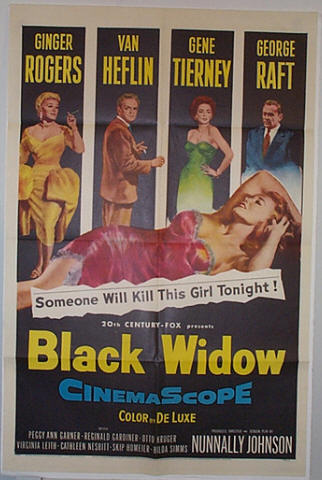
THE BLACK WIDOW
US, 1954, 95 minutes, Colour.
Ginger Rogers, Van Heflin, Gene Tierney, George Raft, Peggy Ann Garner, Reginald Gardiner.
Directed by Nunnally Johnson.
Nunnally Johnson was a prolific screenwriter from 1935 until the mid-70s. His range was wide and he worked for studios on their projects. From 1954 to 1959 he directed a number of films including Night People, Oh Men, Oh Women, The Man in the Grey Flannel Suit. However, his main skill was in writing.
Black Widow is a murder mystery – and could be considered as a kind of All About Eve gone wrong for the central character. Child actor Peggy Ann Garner (Jane Eyre) appears as an innocent young actress who is befriended by a Broadway producer (Van Heflin). When she is murdered, suspicion focuses on the producer. In flashbacks, it appears that the naïve young actress was much more ruthless and ambitious than first thought. The supporting cast is very strong including Ginger Rogers as the actress (the variation on the Bette Davis role). Gene Tierney appears as Van Heflin’s wife and George Raft is the investigating detective.
The film was one of the first made in Cinemascope – illustrating how Cinemascope could be used for ordinary contemporary dramas and not just for historical epics.
The film is a kind of soap opera murder mystery – and entertaining in a popular kind of way.
1. Was this an enjoyable murder mystery? Why? Was it a good 'who done it'? How did it involve audience curiosity? The vicarious enjoyment of participating in a murder mystery?
2. Comment on the tone and style of the film: wide screen colour, New York location, theatrical background? The importance of the title and the initial explanation of the Black Widow spider? What did this add to the film and audience expectations?
3. The picture of’ a girl on the make? Her seeming innocence a seeming victim? Yet the reality of the truth? Her leaving the mid-west, her calculated planning in New York, her using people, her emotional responses? Her flouting of conventions and the inevitable*ty of her murder? What insight into the character of the girl was given?
4, How well did the film use murder mystery conventions: the array of characters. the structure of the film, the initial meeting, flashback explanations, the search for the truth. the hero search, the revelation by the detective? How successful were the clues: how well were they communicated and visualised?
5. How much audience sympathy was there with Peter? His innocence his explanation of what went on, the time shift explanation by him? The fact that he was a victim?
6. What kind of person was Peter? Was he a credible character? As a man, relating to his wife, his theatrical role, his seeking out the truth, his suffering at being the victim?
7. Comment on the presentation of the girl and the gradual revelation of the truth about her: innocent, a spider, the web that she wove, the explanations that she gave, her skill in getting sympathy? The implications of suicide and the switch to murder?
8. The actress? How important was Ginger Rogers' portrayal? Was she suspected at all? Her role in the theatre, her vanity, her bitchiness, her relationship with her husband, audience sympathy for her? Was it credible that she should have killed the girl?
9. The importance of her husband - as subordinate to her, as seeking sympathy, the effect of the girl on him, the pregnancy, his weakness, the effect of’ the murder on him and his concealing the truth?
10. What function did Iris have in the film? Was she ever suspected? Her lack of belief in him? The changing of her opinion? Audiences getting sympathy for Peter from her attitude?
11. The role of the detective - was he a conventional character of different in any way?
12. How important was the contribution of minor characters: the girlfriend, her brother, the waitress who gave Peter the leads, the actor who worked tn the cinema?
13. How well done was the reconstruction of the murder and the revelation of the murderer?
14. Why do audiences become involved in murder mysteries: the plot, the circumstances, the characters? What values are presupposed in an audience for a successful murder mystery?